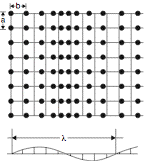Modulated crystal structure
From Online Dictionary of Crystallography
Revision as of 07:51, 4 September 2011 by GervaisChapuis (talk | contribs)
Structure cristalline modulée (Fr.)
Definition
A modulated crystal structure is a density (or atom arrangement) that may be obtained from a density (or atom arrangement) with space-group symmetry by a finite density change (or finite displacement of each atom, respectively) that is (quasi)periodic. A function or a displacement field is periodic if it is invariant under a lattice of translations. Then its Fourier transform consists of δ-peaks on a reciprocal lattice that spans the space and is nowhere dense. A quasiperiodic function has a Fourier transform consisting of δ-peaks on a vector module of finite rank. This means that the peaks may be indexed with integers using a finite number of basis vectors. If the modulation consists of deviations from the basic structure in the positions, the modulation is displacive (displacive modulation, see Figure.). When the probability distribution deviates from that in the basic structure the modulation is occupational.
See also: Displacive modulation.
Figure Caption: Model for a displacively modulated crystal structure. The basic structure is two-dimensional rectangular, with lattice constants a and b, the modulation wave vector is in the b-direction, the wavelength of the periodic modulation is λ such that λ/b is an irrational number.
